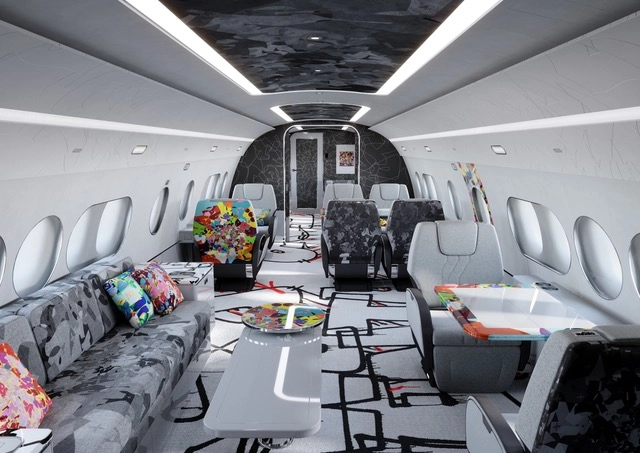
Introduction
The ACJ TwoTwenty or ACJ220 is a short-fuselage business jet that is based on the A220-100, a highly fuel-efficient narrow-body aircraft. It offers seating for up to 135 passengers and can fly non-stop for 12 hours with a 78-foot-long cabin that can be divided into six living zones, accommodating space for up to 19 passengers. As of now, more than 200 of these aircraft are in operation and there are already open orders from different airline customers for an additional 500 aircraft.
What is ACJ220 all about?
ACJ220 is now perfectly timed for airlines struggling under the weight of $8-a-gallon jet fuel. Thanks in part to its lightweight aluminum-lithium fuselage skin, carbon fiber composite wings, explicit fly-by-wire digital flight controls, Collins Pro Line Fusion avionics, and modern Pratt & Whitney PW1500G geared turbofan engines. According to Airbus, the ACJ220 burns 25 percent less fuel, is 25 percent cleaner and 50 percent quieter than older-generation aircraft of comparable size.
However, as a business jet, the ACJ220 looks like an average niche player and suffers from the same weakness as most narrow-body aircraft and regional jets—reaching a quite slow cruising speed of only Mach 0.82 or around 470 knots. Competitor Embraer tried challenging the market for over a decade with its Lineage 1000, a private jet version of its E190 regional jetliner, before abandoning the program in 2020 after delivering just 28 jets over 11 years.
Will the ACJ220 fill the air this time? Will see.
It’s important that Airbus has already faced a backlash in its ACJ product line after ACJ318 was discontinued in 2015 after the manufacturer chose not to offer an updated version with more fuel-efficient engines. Airbus has the resources to pull off the current jet project. Fuel burn on an ACJ220 is 50 percent less than that on an ACJ318. Interior design specialist Comlux has extensive experience with the Airbus product line and should be able to install ACJ220 amenities to meet the most demanding wishes with features such as a king-sized bed, an en suite bathroom with shower, a full office with high-speed internet, many lounges, and electrochromic window shades in a cabin that measures 78 feet long, 6.8 feet tall, and 10.8 feet wide.
While the ACJ220 will not win any transoceanic races in comparison with well-established large-cabin business jets from Bombardier, Dassault, or Gulfstream, it can comfortably operate out of 5,000-foot-long runways at maximum takeoff weight and still carry you non-stop from L.A. to London or Beijing to Melbourne. Of course, it will take a little longer to reach your destination but burning 25 to 50 percent less fuel in the age of pricey jet age is worth the wait.
Newest technologies on board
The ACJ TwoTwenty boasts state-of-the-art technology that allows for an efficient and modern design.
The 3-axis, full-envelope protection Fly-By-Wire system is designed to align with pilot intuition and crew management, it also offers increased safety without compromising control for the pilot.
The flight deck layout, which includes five fully interchangeable large LCD screens (15.1 in), makes it easy for the flight crew to access and share critical flight data.
The avionics suite, Collins Pro Line Fusion, is specifically designed for corporate aviation and is fully integrated with other systems, adding value at every stage of the operation.
The use of composite and advanced materials makes the ACJ TwoTwenty lightweight and easy to fly, with reduced maintenance and extended service life. The aircraft is also equipped with modern Pratt & Whitney GTF PW1500G engines, known for their efficiency in large business aviation, which results in low fuel burn and emissions while being extremely quiet and cities friendly.
Landing systems on board
The ACJ TwoTwenty offers twice the cabin volume compared to other Ultra Long-Range aircraft but has a similar parking footprint and ramp presence. The integrated airstairs ensure autonomy and flexibility for day-to-day operations, so there’s no need to wait for additional ground equipment to board the aircraft.
Urban or challenging airfields are not a problem for the ACJ TwoTwenty, as it is equipped with CAT III autoland, which allows for low visibility approaches (with decision heights lower than 100 ft and runway visibility of less than 250 ft).
The aircraft is also certified for steep approach operations of up to 5.5º glideslope angle, making it capable of handling complex approaches such as those into London City airport.
Flying is easier than ever
The ACJ Two220’s advanced technologies include an improved Flight Management System (FMS) with a graphical interface that simplifies use and training.
The aircraft also has flight plan upload capability and highly integrated systems, allowing the crew to prepare the aircraft for taxi in less than 15 minutes, improving time management and flexibility.
Intuitive and customizable Electronic Checklists (ECL) are designed to maximize pilot awareness and decrease workload, as they are comparatively short to go through.